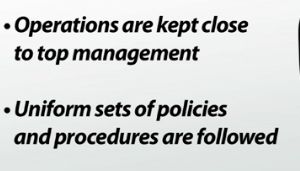Authority in Centralized & Decentralized Organizations
After you watch the video and know the material, click HERE for the quiz.
There are several approaches to authority. In this lesson, learn about the centralized organization, where authority is top-down through a chain of command. Contrast that with the decentralized organization, where authority is assigned at different levels in the hierarchy.
Authority in the Centralized Organization
Today, we will visit two different-sized law firms to see how each exercises authority over their employees.
Our first stop is Bipkin and Bipkin, Esqs., a small law firm of two partners and five employees - one paralegal, two secretaries, a receptionist and a research clerk. When decisions are made about tasks that need to be done, the partners make the decisions. This is an example of a centralized organization.
 |
A chain of command is an order through which authority is shared from top to bottom.
The Bipkins like this arrangement because:
- Operations are kept close to top management
- Uniform sets of policies and procedures are followed
When Bipkin, Sr. needs a legal brief filed with the court, he directs the order to Laurie, the paralegal, with the expectation that it will be done. Should something take her from the task, she is in no way authorized to give the task to another person.
Centralized authority can be a disadvantage. When Laurie noticed that time was running out and the brief was still sitting on her desk, a split-second decision to send secretary Shauna was not possible. The decision would have to be made only by a Bipkin.
 |
Because the Bipkins' practice is quite small and their work is variable, or diversified to include many different facets of a legal case, the span of control, or number of employees that can be managed at one time, is small.
Variable work varies from day to day and requires management's watchful eye. Due to the ever-changing type of tasks, one manager would generally only be adequate for up to six employees. Laurie, Shauna and the other employees perform a variety of tasks with strict deadlines. A smaller span of control over the staff means the partners can oversee everything the others are doing.
Fixed work, or work that never changes, does not require tight management, and as many as twenty employees can be managed by one manager.
 |
Authority in the Decentralized Organization
At Lawyers We Are, Inc., there are several partners, a team of paralegals and a pool of secretaries. There are even delivery people so the paralegals do not have to drive to court.
Lawyers We Are is a decentralized organization that has multiple smaller layers of management on all levels throughout the organization. This structure is necessary because there are so many departments.
There is a criminal law department, a civil law department and a real estate law department, and within each of these departments there are smaller groups of employees like paralegals, secretaries and file clerks. There is also a driver assigned to each department.
Mr. Quigley is a lawyer in the criminal law department. He oversees a few paralegals, several secretaries and a driver. He passes orders from top managing partners to the employees below him.
 |
Quigley gathers files for the week and delegates work to his staff. If decisions need to be made about a case (that do not involve law), the assignees can make them.
 |
Lesson Summary
In summary, in a centralized organization, authority is top-down through a chain of command. The number of hierarchal tiers needed to channel work will determine the span of control amongst each manager.
A chain of command is an order through which authority is shared from top to bottom, while span of control is the number of employees that can be managed at one time.
The type of tasks the employees are assigned determines span of control. Variable work is work that changes daily and requires a smaller span of control. Fixed work is work that is the same every day, with few changes. The span of control can be up to twenty employees.
Conversely, in a decentralized organization, authority is assigned at different levels in the hierarchy. Managers delegate tasks to lower-level managers and assign responsibilities and accountability for the outcomes.
Managers in a decentralized organization pass responsibilities and accountability down from one level of management to a lower level or to an employee. This is called delegation.